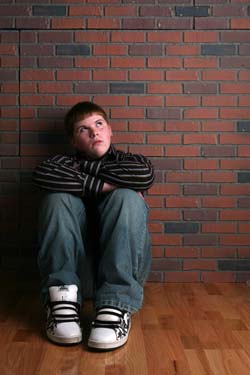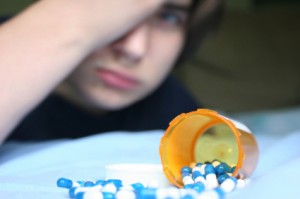Familial Aggregation of Major Depression Predicts Risk of Major Depression
Gronemann et al reported in JAMA Psychiatry: “In this cohort study of 2,903,430 individuals, maternal, paternal, full sibling, or half-sibling with MD were associated with 2-fold higher risks of MD in men and women….(E)xposure to family MD during childhood and adolescence was associated with increased risk. The risk increased with number of affected family members; (however) individuals exposed when 30 years or older had markedly lower risk.”
Editors Note: Even depression in grandparents adds further to the risk of depression. When there is high familial loading for depression and other psychiatric illnesses, one should be alert to the possible onset of depression in young individuals and treat them early and well accordingly.
Early Precursors of Mood Disorders in Young Children of Parents with Bipolar or Unipolar Disorder

At the 2020 meeting of the International Society for Bipolar Disorders, researcher Caroline Vandeleur presented findings from a 13-year study of children in Switzerland who have a parent with bipolar disorder or major depressive disorder. In contrast to findings from the US presented by Danella Hafeman, Vandeleur and colleagues found no evidence of psychopathology in 4 year-olds. They did find that in 7-year-olds, children of a parent with major depressive disorder were four times more likely to have a separation anxiety disorder. In an overall sample of 449 children with a mean age of 10 who were followed up for 13 years, major depression tended to be preceded by anxiety disorders. Participants who went on to be diagnosed with bipolar disorder had earlier symptoms of depression, subthreshold hypomania, conduct disorders, and drug abuse. These were especially common in those who had a parent with bipolar disorder.
Editor’s Note: These data indirectly confirm other observations in which children at high risk for mood disorders in the US showed earlier signs of psychopathology than those in other countries including the Netherlands and Canada.
Clinical Risk Prediction in Youth at Risk for Bipolar Spectrum Disorder and Relapse

Researchers from two 15-year studies of bipolar youth, COBY (The Coarse and Outcome of Bipolar Youth Study) and BIOS (Bipolar Offspring Family Study), have used the longitudinal data from their studies in order to create a risk calculator that can predict an individual’s likelihood of illness.
At the 2020 meeting of the International Society for Bipolar Disorders, researcher Danella Hafeman presented research on a risk calculator that predicts the 5-year risk for onset of a bipolar disorder spectrum diagnosis (BPSD) in young people at high risk and can reasonably distinguish those who will receive a diagnosis from those who will not.
Some of the factors used in the risk calculator include dimensional measures of mania, depression, anxiety, and mood lability; psychosocial functioning; and the age at which parents were diagnosed with a mood disorder.
Hafeman reported that there was a 25% risk that offspring of a bipolar parent would develop a bipolar disorder spectrum diagnosis. In a population ranging in age from 6 to 18 years, Hafeman and colleagues found that anxiety and depression symptoms were a sign of vulnerability to a bipolar spectrum disorder, while subthreshold manic symptoms indicated that a bipolar spectrum disorder could soon emerge. Sudden or exaggerated changes in mood were also an important predictor of BPSD.
Hafeman and colleauges noted that even in children as young as 2 to 5 years old, there were already signs of anxiety, aggression, attention problems, depression, and sudden mood changes in those who would go on to receive a diagnosis of bipolar spectrum disorder.
The researchers were also able to predict which patients with BPSD would have a relapse. According to Hafeman and colleagues, “The most influential recurrence risk factors were shorter recovery lengths, younger age at assessment, earlier mood onset, and more severe prior depression.”
Editor’s Note: Offspring of a parent with bipolar disorder are at high risk for anxiety, depression, attention deficit hyperactivity disorder (ADHD), oppositional defiant disorder, and bipolar disorder. Parents should be alert for the symptoms of these illnesses and seek evaluation and treatment for their children as necessary. Parents should also be aware of the risk factors above that contributed to the risk calculator.
Parents can aid physicians in their evaluation by joining our Child Network and keeping weekly ratings of their children’s symptoms of depression, anxiety, ADHD, oppositional behavior, and mania.
Fish Oil Monotherapy on Depression in Adolescents at High Risk for Bipolar I Disorder: Ambiguity Persists

Researcher Robert K. McNamara and colleagues reported in the Journal of Child and Adolescent Psychopharmacology in a 2020 article that 12 weeks of treatment with omega-3 fatty acids in the form of fish oil did not reduce depression symptoms in adolescents at risk for bipolar disorder when compared to placebo. The primary outcome measured was the results of the Childhood Depression Rating Scale-Revised (CDRS-R).
Fish oil did perform better than placebo on two parts of the rating scale: symptom severity and symptom improvement, especially in weeks 11 and 12 of the study. Omega-3 fatty acids increased creatine and choline in the anterior cingulate, and also increased polyunsaturated fatty acids in red blood cells. The treatment was safe and well-tolerated.
A total of 42 patients between the ages of 9 and 21 who had been diagnosed with depression and had at least one parent with bipolar I disorder received either placebo or 3 fish oil capsules per day. Each capsule contained 450?mg EPA, 40?mg docosapentaenoic acid (DPA), and 260?mg DHA for a total daily dose of 2130?mg EPA + DHA.
Editor’s Note: Ambiguity persists about whether omega-3 fatty acids can improve unipolar or bipolar depression, attention-deficit hyperactivity disorder (ADHD), or prevent the progression of schizophrenia symptoms to the full syndrome. Given the lack of side effects, and the documented effects on red blood cells and brain choline, clinical use of these compounds could be considered in some circumstances.
Predicting Onset of Bipolar Disorder in Children at High Risk: Part II
At the 2019 meeting of the American Academy of Child and Adolescent Psychiatry, one symposium was devoted to new research on predicting onset of bipolar disorder in children who have a family history of the disorder. Below are some of the findings that were reported.
Early Recognition and Treatment Needed
Researcher Boris Birmaher, the discussant of the symposium, described a sample of 100 children between the ages of 2 and 5; half had a parent with bipolar disorder, and these were compared to community controls. Those children who had a parent with bipolar disorder had a high incidence of attention-deficit hyperactivity disorder (ADHD) and ODD, and their conversion to a diagnosis of bipolar disorder was predicted by early age of onset of bipolar disorder in the parent (again) and by the presence of family conflict.
Birmaher emphasized that a delay before children and adolescents with bipolar disorder received their first treatment for the illness had terrible effects—more suicide attempts, completed suicides, substance abuse, and school failure. Birmaher urged early recognition of bipolar disorder and adequate treatment in order to delay onset of the disorder and to render its course more benign.
Childhood-Onset Bipolar Disorder Incidence
Researcher Anna Van Meter and colleagues showed that the incidence of bipolar disorder in children is about 2% worldwide. Researcher Kathleen Merikangas and colleagues report that 80% of adolescents with a bipolar spectrum disorder are not receiving any kind of treatment. Researcher Ben Goldstein indicated that about 50% of those with a full diagnosis of bipolar disorder receive treatment in Canada (where such treatment is cost-free).
Delayed Treatment Leads to Compounding Challenges
Since longer intervals without treatment predict poorer outcomes in bipolar disorder and schizophrenia, and early onset bipolar disorder has been linked to longer delays before first treatment, a significant number of children, particularly in the US, are at risk for disastrous outcomes. Earlier recognition and treatment is imperative, especially since even bipolar disorder not otherwise specified (BP-NOS) can be severe, impairing, associated with multiple simultaneous comorbid diagnoses, and has a familial (genetic) basis.
Predicting Onset of Bipolar Disorder in Children at High Risk: Part I
 At the 2019 meeting of the American Academy of Child and Adolescent Psychiatry, one symposium was devoted to new research on predicting onset of bipolar disorder in children who have a family history of the disorder. Below are some of the findings that were reported.
At the 2019 meeting of the American Academy of Child and Adolescent Psychiatry, one symposium was devoted to new research on predicting onset of bipolar disorder in children who have a family history of the disorder. Below are some of the findings that were reported.
Symptom Progression
In offspring of parents with bipolar disorder, researcher Anne Cecilia Duffy found that symptoms in the children tended to progress in a typical sequence. Childhood sleep and anxiety disorders were first to appear, then depressive symptoms, then bipolar disorder.
Different Types of Illness May Respond Best to Different Medications
Duffy’s research also suggested links between illness features and a good response to specific medications. Those offspring who developed a psychotic spectrum disorder responded best to atypical antipsychotic medication. Those with classical episodic bipolar I disorder responded well to lithium, especially if there was a family history of lithium responsiveness. Those offspring with bipolar II (and anxiety and substance abuse) responded well to anticonvulsant medications.
If parents with bipolar disorder had experienced early onset of their illness, their children were more likely to receive a diagnosis of bipolar disorder.
The offspring of lithium-responsive parents tended to be gifted students, while those from lithium non-responders tended to be poorer students.
Comparing Risk Factors for Bipolar Disorder and Unipolar Depression
Researcher Martin Preisig and colleagues also showed that parental early onset of bipolar disorder (before age 21) was a risk factor for the offspring receiving a diagnosis of bipolar disorder. Parental oppositional defiant disorder (ODD) was also a risk factor for bipolar disorder in the offspring. The emergence of depression, conduct disorder, drug use, and sub-syndromal hypomanic symptoms also predicted the onset of mania during childhood.
Conversely, sexual abuse and witnessing violence were strong risk factors associated with a diagnosis of major (unipolar) depressive disorder. Being female and experiencing separation anxiety were also factors that predicted unipolar depression.
Predicting Conversion to Mania
Researcher Danella M. Hafeman reported that mood swings (referred to in the literature as “affective lability”), depression/anxiety, and having a parent who had an early onset of bipolar disorder were linked to later diagnoses of mania. Immediate risk factors that predicted an imminent onset of mania included affective lability, substance abuse, and the presence of sub-threshold manic symptoms.
Family Focused Therapy Effective in Youth at Risk for Bipolar Disorder Who Have Early Symptoms
 Researcher David Miklowitz developed Family Focused Therapy (FFT), in which families of young people at risk for bipolar disorder take part in therapy, learning about the illness and practicing strategies for communication and coping.
Researcher David Miklowitz developed Family Focused Therapy (FFT), in which families of young people at risk for bipolar disorder take part in therapy, learning about the illness and practicing strategies for communication and coping.
At a symposium at the 2019 meeting of the American Academy of Child and Adolescent Psychiatry, Miklowitz reported findings from recent studies of youth who were at high risk for bipolar disorder because of a family history of the illness and the presence of early symptoms such as depression or cyclothymia or bipolar not otherwise specified (BP-NOS). Family focused therapy reduced symptoms. It also slowed onset of a first episode of mania and slowed the conversion to a diagnosis of bipolar I or bipolar II. These results converge with a total of 10 other positive studies of family focused therapy in different populations in children and adults. FFT or its equivalent should be made available to all symptomatic children who are at risk for bipolar disorder because of a family history of the disorder.
Potential Problems when Youth at Risk for Bipolar Disorder Take SSRIs
 At a symposium at the 2019 meeting of the American Academy of Child and Adolescent Psychiatry, researcher Manpreet Singh reported that in youth at high risk for bipolar disorder, 53% had an adverse event while taking a selective serotonin reuptake inhibitor antidepressant (SSRI), and 26% had a new onset of suicidality while taking an SSRI. These adverse events were associated with reduced size and increased activation of the amygdala, the brain region responsible for emotion processing. Singh concluded that dysfunction in the prefrontal-limbic network may predict adverse events in children at risk for bipolar disorder when they are given SSRI antidepressants. She urged caution in the use of antidepressants in this population. Researcher Joseph Biederman echoed this caution later in the meeting.
At a symposium at the 2019 meeting of the American Academy of Child and Adolescent Psychiatry, researcher Manpreet Singh reported that in youth at high risk for bipolar disorder, 53% had an adverse event while taking a selective serotonin reuptake inhibitor antidepressant (SSRI), and 26% had a new onset of suicidality while taking an SSRI. These adverse events were associated with reduced size and increased activation of the amygdala, the brain region responsible for emotion processing. Singh concluded that dysfunction in the prefrontal-limbic network may predict adverse events in children at risk for bipolar disorder when they are given SSRI antidepressants. She urged caution in the use of antidepressants in this population. Researcher Joseph Biederman echoed this caution later in the meeting.
7-Year-Olds At Risk for Schizophrenia, But Not Bipolar Disorder, Show Specific Types of Cognitive Dysfunction
 A large Danish study investigated whether children at risk for schizophrenia and bipolar disorder would show signs of cognitive problems. The study by researcher Nicoline Hemager and colleagues was published in the journal JAMA Psychiatry in 2018.
A large Danish study investigated whether children at risk for schizophrenia and bipolar disorder would show signs of cognitive problems. The study by researcher Nicoline Hemager and colleagues was published in the journal JAMA Psychiatry in 2018.
The researchers identified 7-year-olds,197 who had family members with schizophrenia, 118 who had family members with bipolar disorder, and 199 control 7-year-olds with no family history of these illnesses. Those children at risk for schizophrenia had significantly more cognitive deficits and behavioral disorders than the controls, while those children at risk for bipolar disorder did not differ significantly from the controls. The deficits among the children at risk for schizophrenia were in the areas of processing speed and working memory, executive and visuospatial functions, and declarative memory and attention.
The researchers indicated that the neurocognitive profile seen in the children at risk for schizophrenia could help clinicians identify these children for early intervention.
Lithium Better than Other Mood Stabilizers for Youth with Bipolar Disorder
A new study by Danella M. Hafeman and colleagues finds that lithium is superior to other mood stabilizers in young people. The data in this case come from 340 youth aged 7–17 who participated in a study known as Course and Outcome of Bipolar Youth (COBY).
At each visit over an average of 10 years, participants reported medications taken, symptoms they had experienced, etc. during the preceding six-month period. During times that participants had taken lithium (compared to other mood stabilizers) they were older, on fewer antidepressants, and they were less likely to have an anxiety disorder.
Those participants who took lithium had half as many suicide attempts, fewer depressive symptoms, less psychosocial impairment, and less aggression than those who took other mood stabilizers.
The researchers concluded, “Findings are consistent with adult studies, showing that lithium is associated with decreased suicidality, less depression, and better psychosocial functioning. Given the paucity of evidence regarding lithium in children and adolescents, these findings have important clinical implications for the pharmacological management of youth with bipolar disorder.”
Editor’s Note: Lithium should especially be considered in those with a family history of mood disorders, and in particular in those with a family history of good response to lithium. Lithium is under-prescribed in both adults and children and should be given much higher consideration in light of the multiple benefits it provides in addition to mood stabilization. These include maintenance of memory, increases in longevity (perhaps based in its ability to increase the length of telomeres, the bits of protective material at the end of DNA strands that deteriorate with age and illness), and neuroprotection against loss of gray and white matter volume in the brain, which often occurs in mood disorders.



